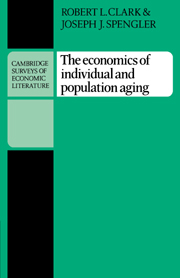Book contents
- Frontmatter
- Contents
- Preface
- 1 Recognition of the economics of aging
- 2 Population aging: sources
- 3 Population aging and dependency
- 4 Economic status of the elderly
- 5 Age and economic activities: life-cycle patterns
- 6 Labor supply of the elderly
- 7 Personal and market characteristics affecting retirement
- 8 Pensions and the economy
- 9 Macroeconomic response to age-structural change
- 10 Conclusion
- Notes
- Bibliography
- Index
2 - Population aging: sources
Published online by Cambridge University Press: 06 October 2009
- Frontmatter
- Contents
- Preface
- 1 Recognition of the economics of aging
- 2 Population aging: sources
- 3 Population aging and dependency
- 4 Economic status of the elderly
- 5 Age and economic activities: life-cycle patterns
- 6 Labor supply of the elderly
- 7 Personal and market characteristics affecting retirement
- 8 Pensions and the economy
- 9 Macroeconomic response to age-structural change
- 10 Conclusion
- Notes
- Bibliography
- Index
Summary
Population aging is represented by an increase in the relative number of older persons (e.g., those over 60 or 65 years of age) in a population; it is reflected also in the associated increase in the median age of the population. Population aging thus is a counterpart to population “youthening” and the associated decline in the median age of the population (United Nations, 1951, 1956, 1973; U.S. Bureau of the Census, May 1975). Population aging tends to emerge in a mature low fertility population, whereas “youthening” may characterize a high-fertility population experiencing declining mortality among the young (Spengler, 1968).
In as much as awareness of the demographic sources of population aging is conditioned by the sensitivity of available demographic measures, we shall point first to the development of these measures. Later we shall review population changes that led to the emergence of population aging and conditions associated with it. Socioeconomic characteristics of older populations (U.S. Bureau of the Census, Nov. 1975), and implications of population aging are examined in later chapters.
Indicators of population aging
Although the age composition of a population may be affected by changes in mortality, fertility, and net external migration, careful measures of the extent of these effects were slow to be developed. Indeed, their perfection awaited the development of the concept of a stable population, a concept suggested by Leonard Euler in 1760 and later anticipated by Laplace and Quetelet (Coale and Demeny, Chapter 1; Keyfitz, 1976; Lotka, 1907, 1925; also, Unsigned, 1976). However, it was not fully articulated until 1907 by A. J. Lotka, who along with F. R. Sharpe demonstrated it in 1911 (Dublin et al., pp. 241–56; Lotka, 1925, pp. 109–20).
- Type
- Chapter
- Information
- The Economics of Individual and Population Aging , pp. 10 - 27Publisher: Cambridge University PressPrint publication year: 1980

